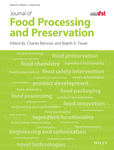Proximate composition, provitamin A retention, and shelf life of extruded orange-fleshed sweet potato and bambara groundnut-based snacks
Funding information: Innovative Agriculture Research Initiative (iAGRI)
Abstract
Evaluating the effect of processing on nutrient content and shelf life is important when developing new products. Six formulations of orange-fleshed sweet potato (OFSP) and bambara groundnut were extruded at a feed rate of 10.15 kg/hr, screw speed of 30 rpm and at 100 and 130 °C in first and second zones respectively. Proximate composition was determined using standard methods. Provitamin A was determined using high-performance liquid chromatography. An untrained panel (n = 73) was used to determine consumer acceptability. Shelf life was predicted by using peroxide values. Concentration of OFSP or bambara groundnut significantly (p < .05) affected proximate composition of the snacks. Moisture (4.79–8.34 g/100 g), carbohydrates (55.53–78.99 g/100 g) and provitamin (0.54–17.33 mg/100 g) contents increased with increase in proportion of OFSP. Protein (4.08–15.03 g/100 g), fat (4.20–12.74 g/100 g), fiber (5.29–6.46 g/100 g), ash (0.09–4.80 g/100 g), and energy (366.13–396.9 kcal/100 g) increased with increasing proportion of bambara groundnut in the formulation. Extrusion significantly (p < .05) reduced provitamin A content from 0.90–20.73 to 0.54–17.33 mg/100 g. Presence of OFSP improved provitamin A retention and consumer acceptability. Predicted shelf life (ranged from 118 to 150 days at room temperature) was inversely proportional to the concentration of bambara groundnut.
Practical applications
Vitamin A deficiency (VAD) is the leading cause of preventable blindness affecting many children and women of reproductive age globally. Provitamin A enriched foods can be developed from locally available provitamin A-rich foods and their consumption promoted to help prevent VAD. In this study, recipes incorporating orange-fleshed sweet potatoes and bambara groundnut were used to develop acceptable and shelf stable vitamin A enriched extruded snacks. The formulations and process used in this study can be adopted at commercial level to produce affordable snacks that can contribute towards reducing the burden of VAD. The results from this study can also be used in similar studies to develop nutrient enhanced extruded snacks.
CONFLICT OF INTEREST
The authors have no conflicts of interest to declare.




